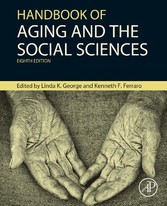
Handbook of Aging and the Social Sciences
von: Linda George, Kenneth Ferraro
Elsevier Reference Monographs, 2015
ISBN: 9780124172852
Sprache: Englisch
550 Seiten, Download: 8652 KB
Format: EPUB, PDF, auch als Online-Lesen
Aging and the Social Sciences
Progress and Prospects
Linda K. George1 and Kenneth F. Ferraro2, 1Center for the Study of Aging and Human Development, Duke University, Durham, NC, USA, 2Center on Aging and the Life Course, Purdue University, West Lafayette, IN, USA
The purpose of this is to highlight recent advances in social science research on aging and identify high priority topics for future research. It is organized into four sections. The first section reviews theoretical and conceptual developments in the field; the second provides an update of advances in data, methods, and statistical techniques that have become central in aging research. The third and longest section reviews three thematic topics that have emerged as cutting-edge issues in social research on aging and the life course. In the concluding section, we briefly comment upon the broader issue of how aging research contributes to major issues and assumptions in the social sciences.
Keywords
Theory; Methods; Longitudinal data; Cohort analysis; Individual and social change; Social disruptions
Outline
Theoretical and Conceptual Developments 4
Cumulative Advantage/Disadvantage Theory 5
Cumulative Inequality Theory 6
Emerging Themes in Aging Research 9
Increased Attention to Cohort Analysis 9
The Effects of Social and Economic Disruptions on Aging 10
Gradual, Incremental Cultural Change 12
What Aging Research Contributes to the Social Sciences: The Big Picture 16
References 20
“The only constant is change.” This quote, heard frequently today, is attributed to Heraclitis of Ephesus, a Greek philosopher who lived from approximately 535 BC to 475 BC. One wonders what it was about life at about 500 years before the birth of Christ that led Heraclitis to that conclusion. Was the pace of social change so rapid that it led to this inference? Was it the rhythms of nature that triggered this observation? Or, perhaps, was it the flow of everyday life that convinced Heraclitis that he was not the same person today that he was yesterday or would be tomorrow? At any rate, it is clear that humans have long been aware that change is ubiquitous.
Scholars of aging arguably devote more of their intellectual activity to studying and understanding change than those in any other field. Aging itself is change – some of it easily observable; some of it occurring at the cellular and molecular levels and requiring years or even decades to be measurable and the fodder for scientific inquiry. Aging individuals are embedded in macro-, meso-, and micro-environments in which change also is omnipresent. And a fundamental assumption of the social sciences is that those constantly changing environments affect the ways in which people age. Thinking seriously about the complexity of change leads to the conclusion that considerable audacity and fortitude are required to study aging and lay claim to understanding or explaining its dynamics. And yet that is precisely what aging researchers do.
Audacity and fortitude also are required in any attempt to summarize the state-of-the-science with regard to social science aging research. Yet, the goal of this chapter is to provide a partial summary of the state-of-the-field. More specifically, the purpose of this chapter is to review, in broad brush, recent theoretical, methodological, and selected substantive developments in aging research in the social sciences. We used the approximate dates of 1996–2015 as the focus of this review. This is an arbitrary window of time, but we believe that it is a reasonable temporal scope for summarizing current significant issues in aging research.
The chapter is organized into four sections. The first section reviews theoretical and conceptual developments in the field; the second provides an update of advances in data, methods, and statistical techniques that have become central in aging research. The third and longest section reviews three thematic topics that have emerged as cutting-edge issues in social research on aging and the life course. In the concluding section, we briefly comment upon the broader issue of how aging research contributes to major issues and assumptions in the social sciences.
Considerable subjectivity was employed in developing this chapter, especially in identifying emerging substantive issues. It is possible to produce a veritable “laundry list” of recent and emerging themes in aging research. We selected only three, with the unifying theme being “big picture” influences on aging. Undoubtedly, other scholars would have selected other developments in the field. Other scholars may disagree with our labeling these research topics as “recent” or “new.” This is inevitable. Nonetheless, we hope that this chapter captures much of the theoretical, methodological, and substantive “action” of the past two decades in social science research on aging.
Theoretical and Conceptual Developments
Arguably, the biggest “story” in aging research for the past several decades has been developments in, advances in, and the greatly increased volume of research that incorporates the life course perspective. The life course perspective is not a theory per se; rather, it is a set of five principles that contextualize individual lives in a number of ways (Elder, Johnson, & Crosnoe, 2003). The principle of life span development states that human development and aging are lifelong processes – that patterns observable over time link distal and proximal events and experiences across the life course. The principle of agency focuses on the ways that individuals construct their own lives by the choices they make within the opportunities and constraints of their environments. The principle of time and place states that human lives develop in historical and geographic contexts that strongly affect the opportunities and constraints available. The principle of timing states that the effects of events and other experiences vary, depending on the individuals’ ages or life stages. Finally, the principle of linked lives focuses on the social networks and relationships that also structure the opportunities and constraints available to individuals. Although temporality, especially biographical and historical time, is widely viewed as the hallmark of the life course perspective, context is its major foundation.
Questions arise at times about the relationships between life course research and gerontological research, especially whether gerontological theory and research will be or have been eclipsed by the life course perspective. In order to document its strengths, life course scholars sometimes critique gerontological research that does not incorporate one or more principles of the life course perspective. Nonetheless, multiple research questions appropriately focus on late life and need not incorporate explicit life course principles (e.g., studies of variability within the older population, studies that examine the effects of interventions or policies on older adults). Virtually all studies of older adults, however, should recognize that research participants are members of cohorts measured at specific historical times – and therefore it cannot be assumed that the findings will generalize to other cohorts and historical contexts.
Because the life course perspective is not a theory, its principles need to be incorporated and tested in conjunction with established theories. This cross-fertilization of life course principles with mainstream social science theories has expanded rapidly. Several examples provide illustrations of this cross-fertilization but do not comprise a comprehensive inventory of relevant topics. Life course principles of life span development, agency, timing, and linked lives have been incorporated in stress process theory. This research has provided important knowledge about the persistent effects of early severe trauma on the mental health and well-being of older adults (e.g., Danese & McEwen, 2012; Shaw & Krause, 2002). Another profitable area of research focuses on the ways in which educational achievements and occupational choices in young adulthood affect financial security in later life (Cahill, Giandrea, & Quinn, 2006). And perhaps no topic has been more thoroughly investigated than the effects of childhood conditions (traumatic events, persistent poverty, and poor health) on morbidity and mortality in middle and late life (for a review, see Chapter 5, this volume).
Cumulative Advantage/Disadvantage Theory
If there has been a bona fide theory based on the life course perspective, specifically the principle of life span development, it is cumulative advantage/disadvantage theory (CA/DT). The major hypothesis of CA/DT was developed by Robert Merton (1968), who called it the Matthew Effect, based on a verse in the Gospel of Matthew (13:12). The Matthew Effect refers to a pattern in which those who begin with advantage accumulate more advantage over time and those who begin with disadvantage become more disadvantaged over time (Dannefer, 1987;...










